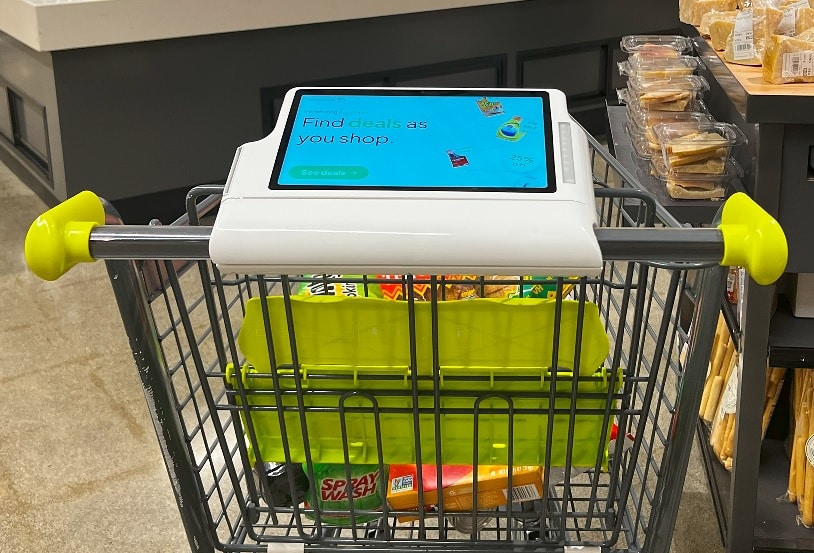Remember when “smart” shopping carts were going to be the next big thing? Forget unloading and ringing up items at the register, or using a mobile device to scan items as you shop – the smart cart would do it all for you, recognizing items and charging your account as you added them to your cart, so you could walk right out of the store when you were done with your grocery shopping.
But one smart cart manufacturer has decided the carts are too expensive, too cumbersome – and shoppers don’t really mind going to traditional checkouts, anyway. So the company is coming up with new ways to make “dumb” carts smarter – at helping you find coupons and deals.
In a new report, the smart cart manufacturer Veeve examines “In-Store Shopper Engagement Built for the Future of Retail,” and how its new iteration of smart carts can play a part.
“Historically, consumers would get their Sunday newspapers for coupons in order to get the best deals in stores,” the report reads. Then along came digital coupons, apps, and online advertising circulars – and inflation. As a result of all of this, “consumers are looking for deals more than ever right now, and are willing to take on new technology to do so.”
New technology like expensive, bulky shopping carts that let you skip the grocery checkout? Well, not quite.
Since its founding in 2018, Veeve has tested out smart shopping carts with several retailers, while competitor Caper tested out its own Smart Cart, and Amazon introduced its Dash Cart.
But “operational issues typically get in the way of success,” Veeve’s report acknowledges. “Cart costs are high,” and they “come with maintenance overhead, can be too small, and don’t stack or nest conveniently.”
So Veeve is reorienting its business around smart carts that are less cumbersome, and have more smarts. Instead of manufacturing entire carts, Veeve is focusing on smart screens that clip onto a store’s existing shopping carts. The cart screen “utilizes the retailers’ own apps to improve the shopper experience,” bringing “the power of online shopping, sensor fusion, and computer vision to physical stores.”
The screens can scan your items as you shop, just like the original smart carts. But they can also display digital store circulars, ads and promotions. And they can sense your location in the store, and deliver digital coupons or tell you about available deals for products in that very aisle.
“Consumers want deals, but they want relevant deals,” Veeve explains. “Combining loyalty information about that consumer, plus where they are in the store gives retailers the ability to drive information that is highly pertinent.”
Whether they’ve used beacons, or QR codes, scan-and-go apps, smart shopping carts, or grab-and-go stores without checkouts at all, retailers haven’t quite settled on how best to integrate technology into the in-store grocery shopping experience. But many shoppers already bring their own technology into the grocery store, in the form of their phones, with the retailer’s app downloaded.
While you might pull out your phone to locate a specific product in the store, or download a coupon, you’re less likely to walk through the grocery aisles with the retailer’s app open and staring at your screen the whole time. That’s where Veeve hopes its smart-cart screens come in. “Knowing a connected screen is right on the shopping cart means no relying on my mobile device in the store,” it says.
So being able to check out without visiting a checkout may not be the high-tech convenience that many shoppers, or retailers, were clamoring for. But coupons and deals, for products relevant to you and specific to products in the aisle you’re in? That might be just what tech-savvy grocery shoppers are looking for.
Veeve certainly hopes so. Otherwise this next generation of smart shopping carts may be due for another round of reeducation.
Image source: Veeve
















